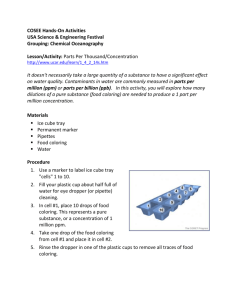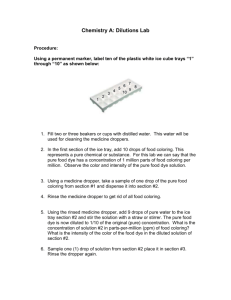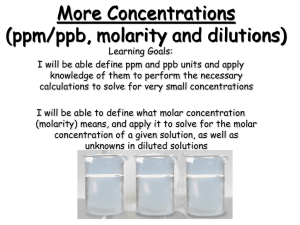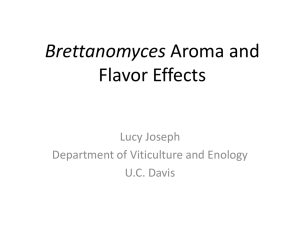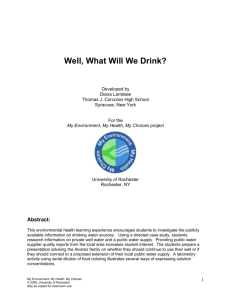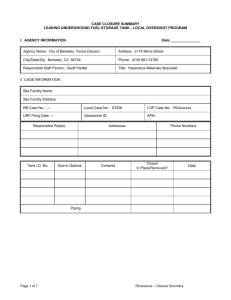Well, What Will We Drink? Ppm, ppb, and Serial Dilution Lab
advertisement
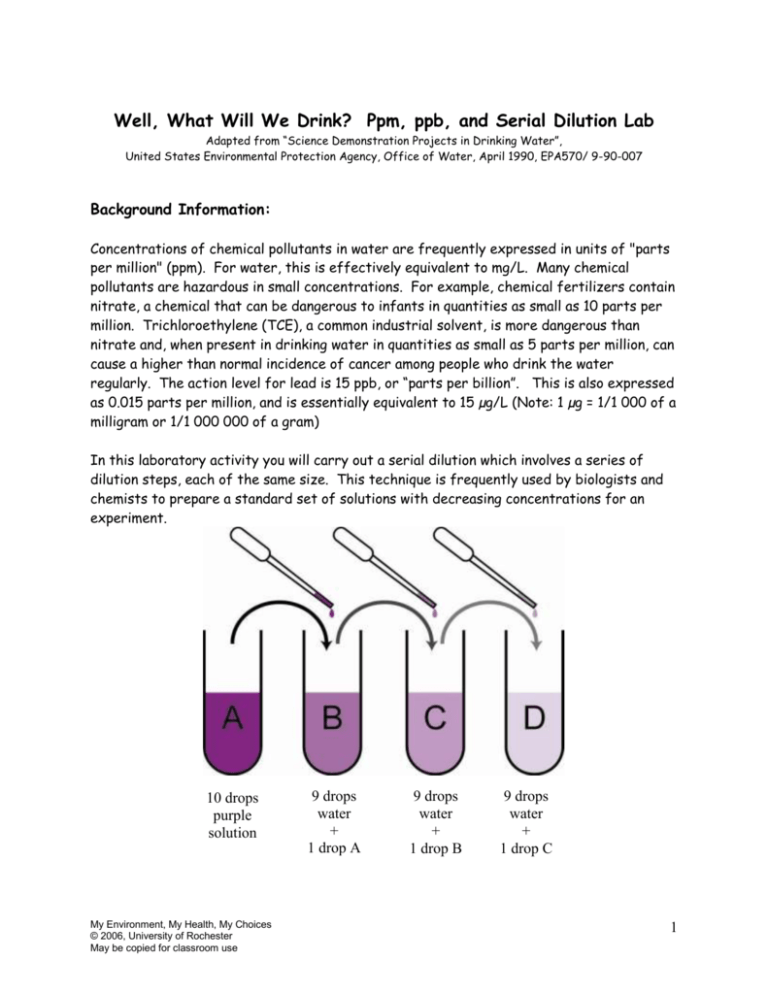
Well, What Will We Drink? Ppm, ppb, and Serial Dilution Lab Adapted from “Science Demonstration Projects in Drinking Water”, United States Environmental Protection Agency, Office of Water, April 1990, EPA570/ 9-90-007 Background Information: Concentrations of chemical pollutants in water are frequently expressed in units of "parts per million" (ppm). For water, this is effectively equivalent to mg/L. Many chemical pollutants are hazardous in small concentrations. For example, chemical fertilizers contain nitrate, a chemical that can be dangerous to infants in quantities as small as 10 parts per million. Trichloroethylene (TCE), a common industrial solvent, is more dangerous than nitrate and, when present in drinking water in quantities as small as 5 parts per million, can cause a higher than normal incidence of cancer among people who drink the water regularly. The action level for lead is 15 ppb, or “parts per billion”. This is also expressed as 0.015 parts per million, and is essentially equivalent to 15 µg/L (Note: 1 µg = 1/1 000 of a milligram or 1/1 000 000 of a gram) In this laboratory activity you will carry out a serial dilution which involves a series of dilution steps, each of the same size. This technique is frequently used by biologists and chemists to prepare a standard set of solutions with decreasing concentrations for an experiment. 10 drops purple solution My Environment, My Health, My Choices © 2006, University of Rochester May be copied for classroom use 9 drops water + 1 drop A 9 drops water + 1 drop B 9 drops water + 1 drop C 1 Purpose: To demonstrate the concept of parts per million (ppm) and parts per billion (ppb). To show how chemicals may be present in very small amounts in water such that they cannot be detected by sight, taste, or smell even though they may still pose a threat to human health. Materials: 9 stirrers (toothpicks) 1 small container of water—used to dilute the solutions with water. 1 large container of water—used for rinsing the pipettes between transfers. 2 plastic dropping pipettes for use in serial dilution procedure—one for water and one for transferring dye solution from one well to another. 1 pipette full or dropping bottle of food coloring 1 white plastic spot plate Procedure: 1. Decide on a system for numbering the wells from 1-10. You will have 2 wells left over. 2. Place 10 drops of food coloring into well #1. This food dye is already a 1/10 solution. The first column of the table is filled out for well #1, as an example. 3. Take one drop from well #1, transfer it to well #2, and return any extra to well # 1. Note: Plastic droppers tend to splatter when almost empty. Don’t try to expel the last drop. Rinse the dropper thoroughly. 4. Using a new dropper, add 9 drops of water to well #2 and stir the solution. Keep this dropper only for water. 5. This solution, in well #2, is now 1/10 of 1/10 or 1/100. Complete the table for this solution. 6. Continue the serial dilution by taking one drop from well #2 and placing it in well #3 then adding 9 drops of clean water (Don’t forget to rinse the food coloring dropper). 7. Continue the serial dilution until all 10 wells are occupied and the table is complete. My Environment, My Health, My Choices © 2006, University of Rochester May be copied for classroom use 2 Observations and Data: Well 1 Fraction 1/10 Decimal 0.1 % 10 % ppm 100,000 Color Visible? Yes, dark My Environment, My Health, My Choices © 2006, University of Rochester May be copied for classroom use 2 3 4 5 6 7 8 9 10 3 Conclusions and Questions: 1. Which was the highest numbered well in which some color was visible? What is the concentration of food coloring in this well in ppm? In percent ? 2. Does a lack of visible color in the remaining wells mean that no food coloring is present? Defend your answer. 3. Design a simple experiment to show that food coloring is still present in all the wells. 4. Which of the wells represents a concentration of 1 part per billion? How many times more concentrated is 5 ppm than 5 ppb? My Environment, My Health, My Choices © 2006, University of Rochester May be copied for classroom use 4 5. One formula for calculating parts per million is: Parts per million = grams of solute grams of solution X 1 000 000 Show a correct numerical set up to demonstrate that a 4 mg/L concentration in water is equivalent to 4 ppm. You may use 1 g/mL as the density of water. Application: An increase of one whole number on the pH scale represents a 10 times decrease in effective acid concentration. For example, an acid solution with a pH of 2 is 10 times less acidic than one with a pH of 1. How many times less acidic is an acid solution with a pH of 5 than one with a pH of 2? To what total volume would you need to dilute 1 liter of a solution with a concentration of 20 ppm of a toxic substance to produce a solution with a concentration of 20 ppb? My Environment, My Health, My Choices © 2006, University of Rochester May be copied for classroom use 5
